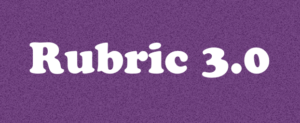According to Hattie and Timperley (2007), feedback, information a learner receives about aspects of their performance, can come from a variety of sources, such as a teacher, parent, classmate, book, or an experience. Feedback makes an impact when it helps to close “the gap between where students are and where they are aiming to be” (p. 90). Its impact on student learning can be significant, although some types of feedback have a greater positive effect than others.
Among other additions, I gave special consideration to the impact of feedback as I created Rubric 3.0, the third iteration of my rubric by which to assess other assessments.
Earlier iterations of this assessment rubric are Rubric 1.0 which you can read about in an earlier blog post, and Rubric 2.0 which you can read about in another earlier blog post.
In the coming weeks, Rubric 3.0 will become Rubric 4.0. By then, it will include ten carefully selected criteria for judging assessment instruments. I look forward to learning more and sharing that rubric soon.
Images
“Feedback” by geralt is licensed under CC0
References
Hattie, J., & Timperley, H. (2007). The power of feedback. Review of Educational Research, 77(1), 81–112.

